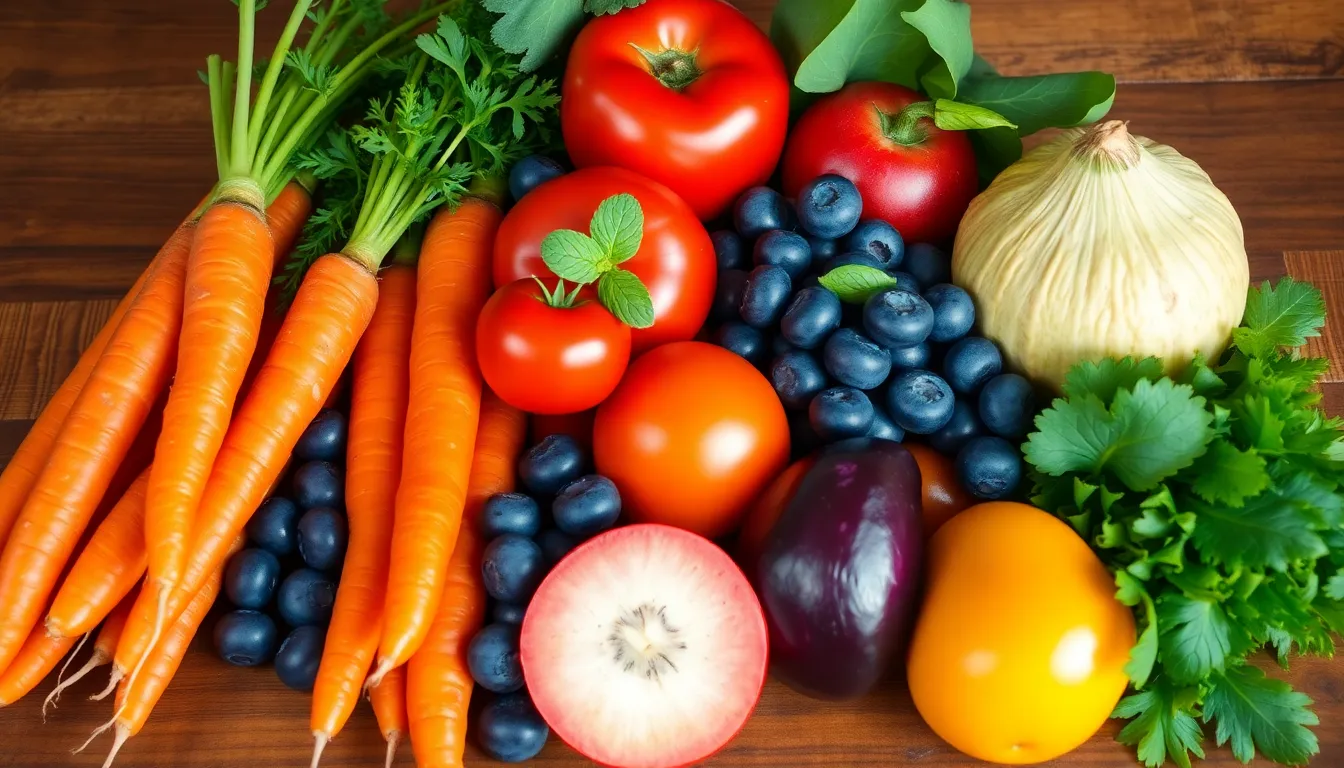Imagine biting into a vibrant plate of food that looks like a rainbow exploded on your table. The colors aren’t just for show; they’re nature’s way of telling you what’s good for your body. From the fiery reds of tomatoes to the deep greens of kale, each hue packs a punch of nutrients that can boost health and elevate mood.
Colour in Food S-40533E1(EXW)
Color in food significantly influences perception and nutrition. Vibrant foods not only attract attention but also offer essential nutrients.
The Importance of Color in Food
Color serves as a visual indicator of nutrient density. Bright reds in tomatoes provide lycopene, which supports heart health. Greens in kale deliver vitamins A, C, and K, promoting overall wellness. Orange hues from carrots signify beta-carotene, crucial for eye health. Each color represents unique phytochemicals that enhance bodily functions. Incorporating a variety of colorful foods guarantees a well-rounded diet.
Psychological Effects of Color on Taste
Color impacts taste perception in numerous ways. Bright colors often evoke feelings of freshness and sweetness, enhancing flavor expectations. For instance, red foods are commonly associated with sweetness, while green foods suggest bitterness. Contrasting colors can create more appealing dishes, leading to greater enjoyment. Research indicates that visually pleasing colors can stimulate appetite, making meals more enjoyable. Different cultures may respond uniquely to specific colors, showcasing the complex relationship between color and taste.
Types of Colors in Food

Colors in food play a crucial role in indicating nutritional content. Two primary categories exist: natural colors and artificial colors.
Natural Colors
Natural colors derive from plant or animal sources. These include carotenoids in carrots, anthocyanins in blueberries, and chlorophyll in leafy greens. Nutritional benefits often accompany these pigments. Carotenoids contribute to eye health, while anthocyanins possess antioxidant properties. Naturally colored foods enrich meals with vitamins, minerals, and phytochemicals, enhancing both visual appeal and health benefits. Many consumers prefer these colors due to their perceived health advantages and fewer processing concerns.
Artificial Colors
Artificial colors, created through chemical processes, enhance the visual appeal of many processed foods. These colors serve to attract consumers and evoke specific emotions. For instance, Red 40 and Yellow 5 are popular additives, commonly found in candies and beverages. Regulatory agencies, such as the FDA, monitor the safety and usage of these dyes. While artificial colors can improve presentation, concerns about potential health risks exist, prompting some consumers to choose natural alternatives. Awareness of these colors can help individuals make informed dietary choices.
Regulations and Standards
Regulatory guidelines for food colorants ensure consumer safety and maintain product integrity. Both natural and artificial additives fall under strict oversight by agencies like the FDA.
Safety Guidelines for Food Colorants
Safety guidelines dictate that food colorants undergo rigorous testing before approval. Acceptable Daily Intake (ADI) levels are established to prevent potential health risks. Additionally, manufacturers must demonstrate that these additives won’t pose adverse effects over a lifetime of consumption. Specific regulations also address the use of certain artificial colors in food products, particularly for vulnerable populations such as children. Many countries classify the safety of colorants, allowing for informed choices among consumers. Compliance with these guidelines helps maintain public trust in food safety.
Labeling Requirements
Labeling requirements necessitate transparency for food colorants. Products featuring artificial colors must clearly indicate them on the ingredient list. Certification numbers associated with certain colorants provide additional information for consumers. Clear designations help individuals identify potential allergens or sensitivities linked to specific additives. Many manufacturers adopt clearer labeling practices to enhance consumer understanding. Compliance with these requirements reinforces accountability in the food industry, promoting informed dietary choices.
The Future of Food Colouring
The landscape of food coloring is evolving rapidly. An increase in consumer awareness regarding health and nutrition shapes future trends.
Trends in Natural Colouring
Natural coloring is gaining popularity as consumers prioritize health-conscious choices. Many food manufacturers now utilize sources like spirulina for blue hues and beet juice for vibrant reds. Kale and spinach provide greens while turmeric is often employed for its golden tint. These plant-based options are not only visually appealing but also offer health benefits. Alongside aesthetic appeal, consumers seek thе nutritional advantages associated with these natural additives. Conversely, trends suggest a decline in artificial color usage, reflecting advocacy for transparency and cleaner labeling.
Innovations in Food Coloring Technology
Technological advancements in food coloring are enhancing options for manufacturers. Innovations in extraction processes allow for concentrated natural colors that maintain vibrant hues. Researchers are exploring the use of microencapsulation to stabilize and prolong the shelf life of natural colorants. Companies now incorporate fermentation techniques to create vibrant pigments without chemical additives. New applications of biotechnology lead to unique color variations, appealing to a diverse consumer base. Sustainability in sourcing also plays a key role, as companies prioritize eco-friendly practices. Each of these advancements contributes to a more vibrant and health-conscious food industry.
Embracing colorful foods
Embracing colorful foods is essential for a nutritious and appealing diet. The vibrant hues not only enhance visual appeal but also provide critical nutrients that support overall health. As consumers become more aware of the benefits of natural colors and the potential risks associated with artificial additives, the food industry is evolving to meet these demands. Innovations in food coloring techniques are paving the way for healthier options while promoting transparency. By prioritizing a variety of colors in their meals, individuals can enjoy not just the aesthetic pleasure but also the myriad health benefits that come with a colorful plate.

